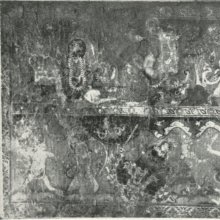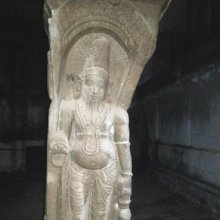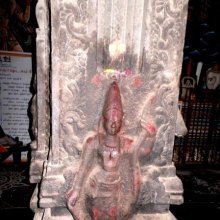Dashavatara, Dasha-avatara, Daśāvatāra, Daśāvatārā, Dashan-avatara: 16 definitions
Introduction:
Dashavatara means something in Hinduism, Sanskrit, Marathi, Hindi. If you want to know the exact meaning, history, etymology or English translation of this term then check out the descriptions on this page. Add your comment or reference to a book if you want to contribute to this summary article.
The Sanskrit terms Daśāvatāra and Daśāvatārā can be transliterated into English as Dasavatara or Dashavatara, using the IAST transliteration scheme (?).
Alternative spellings of this word include Dashavtar.
Images (photo gallery)
In Hinduism
Natyashastra (theatrics and dramaturgy)
Source: archive.org: The mirror of gesture (abhinaya-darpana)Hands of the Ten Avatars of Viṣṇu (Daśāvatāra):
- Matsya,
- Kūrma,
- Narasiṃha,
- Vāmana,
- Paraśurāma,
- Raghurāma,
- Balarāma,
- Kṛṣṇa,
- Kalka;
(Buddha is omitted)
Source: Shodhganga: Elements of Art and Architecture in the Trtiyakhanda of the Visnudharmottarapurana (natya)Daśāvatāra (दशावतार) refers to the “ten incarnations” (of Lord Viṣṇu) to which are assign various hand gestures (in Indian Dramas), according to the Viṣṇudharmottarapurāṇa, an ancient Sanskrit text which (being encyclopedic in nature) deals with a variety of cultural topics such as arts, architecture, music, grammar and astronomy.—In the Hindu scriptures, different stories are found, related to lord Viṣṇu, where we find the magnanimity of different incarnations of lord Viṣṇu. Moreover, a great influence of these ten incarnations of lord Viṣṇu seems to fall in the field of Dance also. In every classical Dance form of India, the daśāvatāra-nṛtya is seen to perform in a graceful way. The gestures and postures used in daśāvatāra-nṛtya are suggestive of the forms of incarnations.

Natyashastra (नाट्यशास्त्र, nāṭyaśāstra) refers to both the ancient Indian tradition (shastra) of performing arts, (natya—theatrics, drama, dance, music), as well as the name of a Sanskrit work dealing with these subjects. It also teaches the rules for composing Dramatic plays (nataka), construction and performance of Theater, and Poetic works (kavya).
Shilpashastra (iconography)
Source: Shodhganga: The significance of the mūla-beras (śilpa)Daśāvatāra (दशावतार) refers to the “ten incarnations of Lord Viṣṇu”, as defined according to texts dealing with śilpa (arts and crafs), known as śilpaśāstras.—The ten avatāras (incarnation) of Lord Viṣṇu are Matsya, Kūrma, Varāha, Narasiṃha, Vāmana, Paraśurāma, Raghurāma, Balarāma, Śrī Kṛṣṇa, and Kalki. The hand gestures for the daśāvatāra in dancing and iconography are similar in some cases and dissimilar in most of the cases.
- Matsya-avatāra,
- Kūrma-avatāra,
- Varāha-avatāra,
- Narasiṃha-avatāra,
- Vāmana-avatāra,
- Paraśurāma-avatāra,
- Raghurāma-avatāra,
- Balarāma-avatāra,
- Kṛṣṇa-avatāra,
- Kalki-avatāra.

Shilpashastra (शिल्पशास्त्र, śilpaśāstra) represents the ancient Indian science (shastra) of creative arts (shilpa) such as sculpture, iconography and painting. Closely related to Vastushastra (architecture), they often share the same literature.
Purana and Itihasa (epic history)
Source: Shodhganga: Elements of Art and Architecture in the Trtiyakhanda of the VisnudharmottarapuranaDaśāvatāra (दशावतार) refers to the “ten incarnations” (of Lord Viṣṇu), according to Puranic literature.—The concept of daśāvatāra was commenced after Vedic period. In the Puranic literature, a great discussion about the ten incarnations of lord Viṣṇu is found in a detailed way. Different Purāṇas viz., Garuḍapurāṇa, Padmapurāṇa, Liṅgapurāṇa etc. talk about the ten incarnations of lord Viṣṇu. The word daśāvatāra is made with two Sanskrit words daśa i.e., ten and avatāra i.e., incarnation. In Hinduism, lord Viṣṇu is worshiped as the preserver of the entire world. Hindu mythology states that-to protect the entire world from evil lord Viṣṇu takes different forms or incarnations. In the Śrīmadbhagavadgītā also, it is stated that to establish religion and to destroy the wicked, lord Viṣṇu manifests in every age.
The ten incarnations of Lord Viṣṇu are—
- Matsya,
- Kūrma,
- Varāha,
- Narasiṃha,
- Vāmana,
- Paraśurāma,
- Śrīrāma,
- Halirāma or Balarāma,
- Kṛṣṇa and
- Kalkī.
But in the Viṣṇudharmottarapurāṇa, the mention of Kalkī Avatāra is not found. Point to be noted hare is that, though in different ancient treatises, the Kṛṣṇa Avatāra is included in the list of ten incarnations of lord Viṣṇu, Sankardeva and Madhavdeva, the two Vaishnava saint of Assam seem to accept the Buddha Avatāra instead of Kṛṣṇa Avatāra.

The Purana (पुराण, purāṇas) refers to Sanskrit literature preserving ancient India’s vast cultural history, including historical legends, religious ceremonies, various arts and sciences. The eighteen mahapuranas total over 400,000 shlokas (metrical couplets) and date to at least several centuries BCE.
General definition (in Hinduism)
Source: Wisdom Library: HinduismDaśāvatāra (दशावतार) is a Sanskrit word referring to the ten incarnations of Viṣṇu. Viṣṇu is the name of a major Hindu deity and forms part of the trinity of supreme divinity (trimūrti) together with Brahmā and Śiva. They are seen as the cosmic personifications of creation (brahmā), maintenance (viṣṇu), and destruction (śiva).
They ten incarnations of Viṣṇu are:
- Matsya,
- Kūrma,
- Varāha,
- Nṛsiṃha,
- Vāmana (Trivikrama),
- Paraśurāma,
- Rāma,
- Kṛṣṇa,
- Buddha,
- and Kalki.
Also see the list of aṃśāvatāra, which includes twenty-one forms of Viṣṇu.
Source: WikiPedia: HinduismDashavatara refers to the ten avatars of Vishnu, the Hindu God of universal preservation. The word Dashavatara derives from daśa, meaning “ten” and avatar (avatāra), meaning “descent”.
Yuga: The first four avatars of Vishnu appeared in Satya or Krita Yuga, the first of the four Yugas, also called 'The Golden Age'. The Kali-yuga is described as ending with the appearance of Kalki, who will defeat the wicked, liberate the virtuous, and initiate a new Satya or Kalki Yuga.
- Matsya, the fish (Satya Yuga).
- Kurma, the tortoise (Satya Yuga).
- Varaha, the boar (Satya Yuga).
- Narasimha, half-man/half-lion (Satya Yuga).
- Vamana, the dwarf, (Treta Yuga).
- Parashurama, Warrior with the axe, (Treta Yuga).
- Rama, Ramachandra, the prince and king of Ayodhya, (Treta Yuga).
- Krishna: the eighth son of Devaki and Vasudeva. (Dwapara Yuga),
- Buddha: Gautama Buddha, the founder of Buddhism (Dwapara Yuga),
- Kalki: final incarnation (end of Kali Yuga).
Languages of India and abroad
Marathi-English dictionary
Source: DDSA: The Aryabhusan school dictionary, Marathi-Englishdaśāvatāra (दशावतार).—m The ten incarnations of viṣṇu.
Marathi is an Indo-European language having over 70 million native speakers people in (predominantly) Maharashtra India. Marathi, like many other Indo-Aryan languages, evolved from early forms of Prakrit, which itself is a subset of Sanskrit, one of the most ancient languages of the world.
Sanskrit dictionary
Source: DDSA: The practical Sanskrit-English dictionaryDaśāvatārā (दशावतारा).—m. (pl.) the ten incarnations of Viṣṇu; see under अवतार (avatāra).
Derivable forms: daśāvatārāḥ (दशावताराः).
Daśāvatārā is a Sanskrit compound consisting of the terms daśan and avatārā (अवतारा).
Source: Cologne Digital Sanskrit Dictionaries: Shabda-Sagara Sanskrit-English DictionaryDaśāvatāra (दशावतार).—m.
(-raḥ) A name of Vishnu. E. daśa ten, and avatāra descent; the deity of whom there are ten descents from heaven, for the purpose of protecting or punishing mankind: see avatāra .
Source: Cologne Digital Sanskrit Dictionaries: Aufrecht Catalogus Catalogorum1) Daśāvatāra (दशावतार) as mentioned in Aufrecht’s Catalogus Catalogorum:—stotra. Oppert. 67. 1118. 2854.
2) Daśāvatāra (दशावतार):—Sv. Ulwar 272.
Source: Cologne Digital Sanskrit Dictionaries: Monier-Williams Sanskrit-English Dictionary1) Daśāvatāra (दशावतार):—[from daśa] m. (= śa-rūpa) Viṣṇu, [cf. Lexicographers, esp. such as amarasiṃha, halāyudha, hemacandra, etc.]
2) [v.s. ...] n. Name of an observance (performed on the 10th day of the light half of Bhādrapada, [Vrata-prakāśa x]), [Bhaviṣya-purāṇa, khaṇḍa 1 & 2: bhaviṣya-purāṇa & bhaviṣyottara-purāṇa ii, 60]
Source: Cologne Digital Sanskrit Dictionaries: Yates Sanskrit-English DictionaryDaśāvatāra (दशावतार):—[daśā+vatāra] (raḥ) 1. m. A name of Vishnu.
[Sanskrit to German]
Sanskrit, also spelled संस्कृतम् (saṃskṛtam), is an ancient language of India commonly seen as the grandmother of the Indo-European language family (even English!). Closely allied with Prakrit and Pali, Sanskrit is more exhaustive in both grammar and terms and has the most extensive collection of literature in the world, greatly surpassing its sister-languages Greek and Latin.
Hindi dictionary
Source: DDSA: A practical Hindi-English dictionaryDaśāvatāra (दशावतार) [Also spelled dashavtar]:—(nm) the ten incarnations of Lord vishnu viz. [matsya, kacchapa, varāha, nṛsiṃha, vāmana, paraśurāma, rāma, kṛṣṇa, buddha] and [kalki].
...
Kannada-English dictionary
Source: Alar: Kannada-English corpusDaśāvatāra (ದಶಾವತಾರ):—
1) [noun] (myth.) collectively, the ten principal incarnations of Viṣṇu.
2) [noun] Viṣṇu himself.
Kannada is a Dravidian language (as opposed to the Indo-European language family) mainly spoken in the southwestern region of India.
See also (Relevant definitions)
Partial matches: Dasa, Avatara, Tacan, Taca.
Starts with: Dashavatara Temple, Dashavataracarita, Dashavataracharita, Dashavataragamjipu, Dashavatarakavya, Dashavatarakhandaprashasti, Dashavataramanjari, Dashavataramurtistotra, Dashavataranritya, Dashavataraparishishta, Dashavatarastotra, Dashavatarastuti, Dashavatarasuprabhata.
Full-text (+32): Kalki, Vamana, Parashurama, Narasimha, Matsya, Varaha, Dashavataracarita, Balarama, Dashavatara Temple, Krishna, Avatara, Incarnation, Raghurama, Narasimhavatara, Kurma, Krishnavatara, Balaramavatara, Parashuramavatara, Kalkyavatara, Vamanavatara.
Relevant text
Search found 17 books and stories containing Dashavatara, Dasa-avatara, Daśa-avatāra, Daśan-avatārā, Dasan-avatara, Daśāvatāra, Dasavatara, Daśāvatārā, Daśavatāra, Dasha-avatara, Dashan-avatara; (plurals include: Dashavataras, avataras, avatāras, avatārās, Daśāvatāras, Dasavataras, Daśāvatārās, Daśavatāras). You can also click to the full overview containing English textual excerpts. Below are direct links for the most relevant articles:
The Matsya Purana (critical study) (by Kushal Kalita)
Part 1.3 - Incarnations of Viṣṇu < [Chapter 4 - Religious aspects of the Matsyapurāṇa]
Puranic encyclopaedia (by Vettam Mani)
Vishnudharmottara Purana (Art and Architecture) (by Bhagyashree Sarma)
2.2. (d): Hand Gestures for Daśāvatāra < [Chapter 3 - Drama and Dance]
Matangalila and Hastyayurveda (study) (by Chandrima Das)
Reviews < [October 1968]
Is There Bhakti Rasa in Mahabharata? < [January – March, 1997]
Ramayana and Five Arts < [January 1952]
Song 9 < [Advaita-tattwa-kathana (Description of the Truth of Lord Advaita)]
Related products




